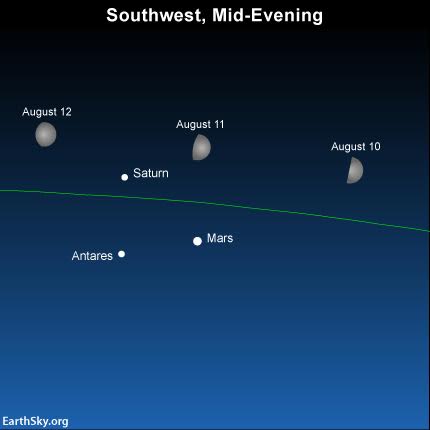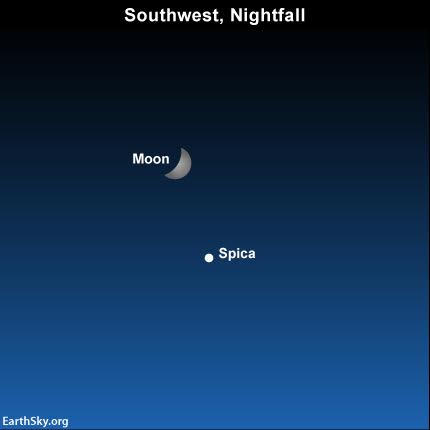Tonight – August 8, 2016 – look low in the southwestern sky for the rather wide waxing crescent moon and the star Spica, the brightest star in the constellation Virgo the Maiden. Don’t wait too late to look for them, for the two will follow the sun beneath the horizon by early-to-mid evening.
Over the next several days days, at nightfall, watch for the moon to move away from Spica and toward the planets Mars and Saturn.

Spica is around 250 light-years from Earth. For this star to shine at 1st-magnitude brightness at this distance must mean this star in intrinsically very luminous indeed. This blue-white gem of a star is thought to be some 1,900 times more luminous than our sun. Read more about the true brightnesses of stars.
Although Spica looks like a single point of light to the eye, it’s actually two stars in one. According to astronomer Jim Kaler, these two component stars are only 0.12 of an astronomical unit apart (0.12 the Earth-sun distance). The two stars in the Spica system revolve around each other in only four days.
Each day, the sun moves eastward along the ecliptic, getting closer and closer to Spica on the sky’s dome. Another way of looking at, Spica is sinking closer and closer to the glare of sunset daily. By mid-October, the sun will meet up with Spica in the constellation Virgo, at which time Spica will rise with the sun, cross the sky with the sun and set with the sun.

Spica’s yearly disappearance at evening dusk is a sure sign of the change of seasons, of summer giving way to autumn in the Northern Hemisphere – or of winter giving way to spring in the Southern Hemisphere. The first day that a star is no longer visible in the evening sky is called the heliacal setting of a star. After its heliacal setting, a star remains lost in the sun’s glare until the sun travels far enough east of the star to allow it to reappear in the east at morning dawn. The star’s first appearance in the morning sky is called its heliacal rising.
Bottom line: As darkness falls on August 8, 2016, watch for the waxing crescent moon to pair up with Spica in the constellation Virgo.
EarthSky astronomy kits are perfect for beginners. Order today from the EarthSky store
Enjoying EarthSky so far? Sign up for our free daily newsletter today!












